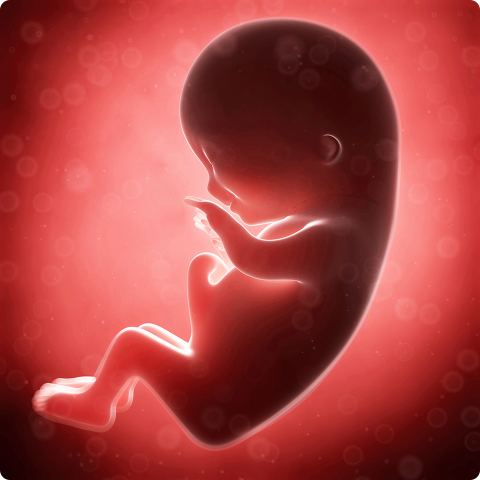13-16 Weeks
13 Weeks Pregnant
Your baby is about 7.4 cms in length crown to bottom (2.91 inches) and weighs about 23 grams (0.81 oz).
Your baby will become very lively this month! They can roll over from front to back and may launch into a somersault; your baby can make stepping movements and can open their arms out wide.
Your baby’s lungs start to make intermittent breathing activities from this week as the baby’s diaphragm begins to work. It starts up in short sessions, repeated a few times an hour, expanding and contracting as it will do full-time after the birth. The baby breathes in small amounts of amniotic fluid which aid the development of the lung tissues.
The ovaries or testes are fully developed inside their body, and the genitals are forming outside their body. Where there was a swelling between the legs, there will now be a penis or clitoris growing, although it is not common to be able to determine the baby’s sex during an ultrasound scan at this point.
The outer structures of your baby’s ears are developing this week, the little eardrums are forming.
14 Weeks Pregnant
Your baby is about 8.7 cms in length crown to bottom (3.42 inches) and weighs about 43 grams (1.52 oz).
Around now, the baby begins to swallow small amounts of amniotic fluid, which pass into the stomach, which can produce minute amounts of digestive juices. Their lips are sensitive and they can use their mouths. The baby’s tongue has developed taste buds and the saliva-making glands are working. Your baby’s kidneys begin to function and they are able to pass swallowed fluid back into the amniotic fluid as urine. The urine is sterile and does not foul the amniotic waters.
The baby’s finger and toes now have nails.
During this next month, the baby’s overall proportions change. The baby’s arms have almost reached the final relative lengths they will be at birth and the baby’s neck has become more defined. The growth of the head slows down, giving the body a chance to catch up. The baby’s facial skeleton begins to remodel to show its individual features which will bare family resemblances, but be unique to your baby.
15 Weeks Pregnant
Your baby is about 10.1 cms in length crown to bottom (3.98 inches) and weighs about 70 grams (2.47 oz).
Fifteen weeks into your pregnancy, or 13 weeks after conception, your baby is growing rapidly. Your baby's skeleton is developing, its tiny bones will become visible on ultrasound images in a few weeks. Your baby's scalp hair pattern also is forming. For girls, ovarian follicles begin forming. For boys, the prostate appears.
The eyes also start to become sensitive to light. Even though your baby's eyes are closed, they may register a bright light outside your body.
16 Weeks Pregnant
Your baby is about 11.6 cms in length crown to bottom (4.57 inches) and weighs about 100 grams (3.53 oz).
The muscles of the baby's face can now move and the beginnings of facial expressions appear. Your baby can't control these yet.
The nervous system continues to develop, allowing the muscles in your baby's limbs to flex. Around this time, your baby's hands can reach each other – they can form a fist, and hold each other when they touch.
In order to fuel the substantial growth that is now occurring for your baby, the placenta is now fully formed. The word placenta comes from the Latin word for ‘cake’. It is the placenta which makes the pregnancy possible, being the baby’s support system. It contains a soft structure of blood vessels belonging to the baby and branching out to look like a tree. The finger-like projections (villi) which burrowed into the wall of your uterus, are incorporated by the placental vessels and are surrounded by maternal blood. The villi absorb, vitamins, minerals, water, oxygen and other vital nutrients from the mother and pass them into the baby’s bloodstream via the umbilical cord, without the two circulations coming into direct contact.
The placenta actively selects, stores, processes and regulates what and how much is taken in according to the baby’s changing needs. The placenta also acts as a limited sieve, protecting the baby from some harmful agents which may present, for example bacterial infections, but this protection is not complete.
The placenta facilitates waste disposal including carbon dioxide and excess red blood cells and ultimately takes over the production of progesterone, the key hormone sustaining the pregnancy.

